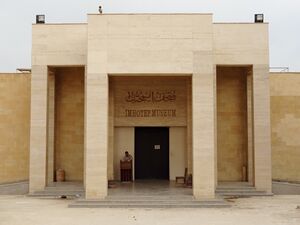متحف إمحوتپ
Imhotep Museum | |
 The museum entrance | |
 | |
| تأسس | April 26, 2006 |
|---|---|
| الموقع | located at the foot of the Saqqara necropolis complex, near Memphis in Lower Egypt |
| النوع | متحف أثري |
متحف إمحوتپ هو متحف أثري located at the foot of the Saqqara necropolis complex, near Memphis في مصر السفلى.
التاريخ
The museum, which was named for the ancient Egyptian architect Imhotep, was opened on April 26, 2006 by سوزان مبارك و برناديت شيراك.[1] Imhotep is credited with being the first Egyptian to build a monumental structure out of stone: Pharaoh Djoser's step pyramid located at Saqqara, which was built during the 3rd Dynasty.
Constructed as part of the strategic site management program of the Supreme Council of Antiquities, the air-conditioned Imhotep Museum provides a more secure storage space than the traditional storehouses located at archaeological sites. In the museum, artefacts are more easily protected from theft, and they are stored in climate-controlled conditions.
The site museum project at Saqqara was conceived of in 1990, but it was not launched until 1997 after the authorities had identified a suitable location on the plateau where the museum could sit unobtrusively and not disturb the natural landscape.[2] Construction was completed in 2003.
محتويات المتحف
The museum has six large halls in which one may admire masterpieces from Saqqara, such as a Ptolemaic mummy discovered by Zahi Hawass during the excavation of the Pyramid of Teti complex and a large double statue that was found near the causeway of the Unas complex. The statue depicts the 19th Dynasty High Priest of Mut, Amenemopet, and his wife.
In the entrance hall, the visitor is welcomed by a fragment of the Djoser statue on which one can read the name of the king and the architect Imhotep. This find was on loan from the Egyptian Museum in Cairo, and was exhibited only in the museum's opening months.[3]
The second hall displays archaeological finds from various excavations on the Saqqara plateau. The artefacts in this exhibit will be rotated.
The third hall is devoted to Egyptian art, and contains vessels, statues, and stelae made of wood and stone, as well as the ancient tools used to build the monuments.
The fourth hall exhibits architectural elements from the Step Pyramid complex, such as columns and the green and blue faience wall tiles that decorate chambers under the pyramid complex. A small statue of Imhotep is also found in this room.
The fifth hall displays objects used in burials from the 6th Dynasty through the New Kingdom.
A gallery dedicated to the French Egyptologist, Jean-Philippe Lauer, displays some of his personal effects and photographs of him at work on the plateau. His library is recreated in one room.[4] Lauer began working at the Djoser complex in the 1920s and continued to work there for the remainder of his career, some 75 years.
انظر أيضاً
المراجع
- ^ "Museum for a demi-god". No. 791. Al-Ahram Weekly Online. April 2006. Archived from the original on 17 February 2012. Retrieved 18 February 2015.
- ^ "Antiquities of Egypt" (PDF). No. 1. Supreme Council of Antiquities Monthly Newsletter. May 2006. Retrieved 18 February 2015.
- ^ "Antiquities of Egypt" (PDF). No. 1. Supreme Council of Antiquities Monthly Newsletter. May 2006. Retrieved 18 February 2015.
- ^ "Imhotep Museum | | Sights".
وصلات خارجية
Official site: https://www.sca-egypt.org/eng/MUS_Imhotep_Museum.html
